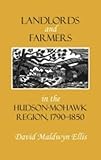Landlords and Farmers in the Hudson-Mohawk Region, 1790–1850 / David Maldwyn Ellis.
Material type: TextPublisher: Ithaca, NY : Cornell University Press, [2018]Copyright date: ©2018Description: 1 online resource (362 p.)Content type:
TextPublisher: Ithaca, NY : Cornell University Press, [2018]Copyright date: ©2018Description: 1 online resource (362 p.)Content type: - 9781501721274
- 333.53
- HD211.N7 E5
- online - DeGruyter
| Item type | Current library | Call number | URL | Status | Notes | Barcode | |
|---|---|---|---|---|---|---|---|
 eBook
eBook
|
Biblioteca "Angelicum" Pont. Univ. S.Tommaso d'Aquino Nuvola online | online - DeGruyter (Browse shelf(Opens below)) | Online access | Not for loan (Accesso limitato) | Accesso per gli utenti autorizzati / Access for authorized users | (dgr)9781501721274 |
Frontmatter -- PREFACE -- CONTENTS -- LIST OF MAPS -- I. The Background -- II. Population Growth and the Land Pattern, 1790-1808 -- III. The Good Years, 1790-1808 -- IV. Years of Uncertainty, 1808-1825 -- V. The Transportation Network, 1825-1850 -- VI. The Rise of the Dairy State, 1825-1850 -- VII. The Antirent Movement, 1839-1845 -- VIII. Antirentism in Politics -- Appendixes -- BIBLIOGRAPHY -- INDEX
restricted access online access with authorization star
http://purl.org/coar/access_right/c_16ec
The transition from a predominantly self-sufficient economy to one primarily dependent on the market in the first half of the nineteenth century was to effect changes in the United States fully as far-reaching if not as spectacular as those accompanying the industrial revolution. Farming as a way of life was yielding place to the concept of farming as a means of profit. Few farmers in the country felt the impact of these revolutionary forces more directly than those of eastern New York State. Indeed, discontent over these changes contributed to the violent Anti-Rent War (1839–1846) centered in the Catskills.How New York farmers met these challenges is the central theme of Landlords and Farmers in the Hudson-Mohawk Region, 1790–1850. Focusing on twenty-one counties in eastern New York, David Maldwyn Ellis describes the process of settlement, the growth of population, and the characteristics of pioneer agriculture; traces the rapid shifts from grain culture to sheep raising and dairying; and points out the variety of individual and local adjustments caused by differences in soil, topography, accessibility to market, cultural legacies, and individual enterprise. Ellis also contrasts the forces leading to rural decline with the beginnings of scientific husbandry and agricultural education; evaluates the role of roads, canals, and railroads, and outlines the land pattern and the effect of leasehold upon the region's agrarian development.In short, this classic work of American agricultural history and the history of New York State—originally published by Cornell in 1946—chronicles the transformation of the pioneer farmer into the dairyman.
Mode of access: Internet via World Wide Web.
In English.
Description based on online resource; title from PDF title page (publisher's Web site, viewed 26. Apr 2024)


